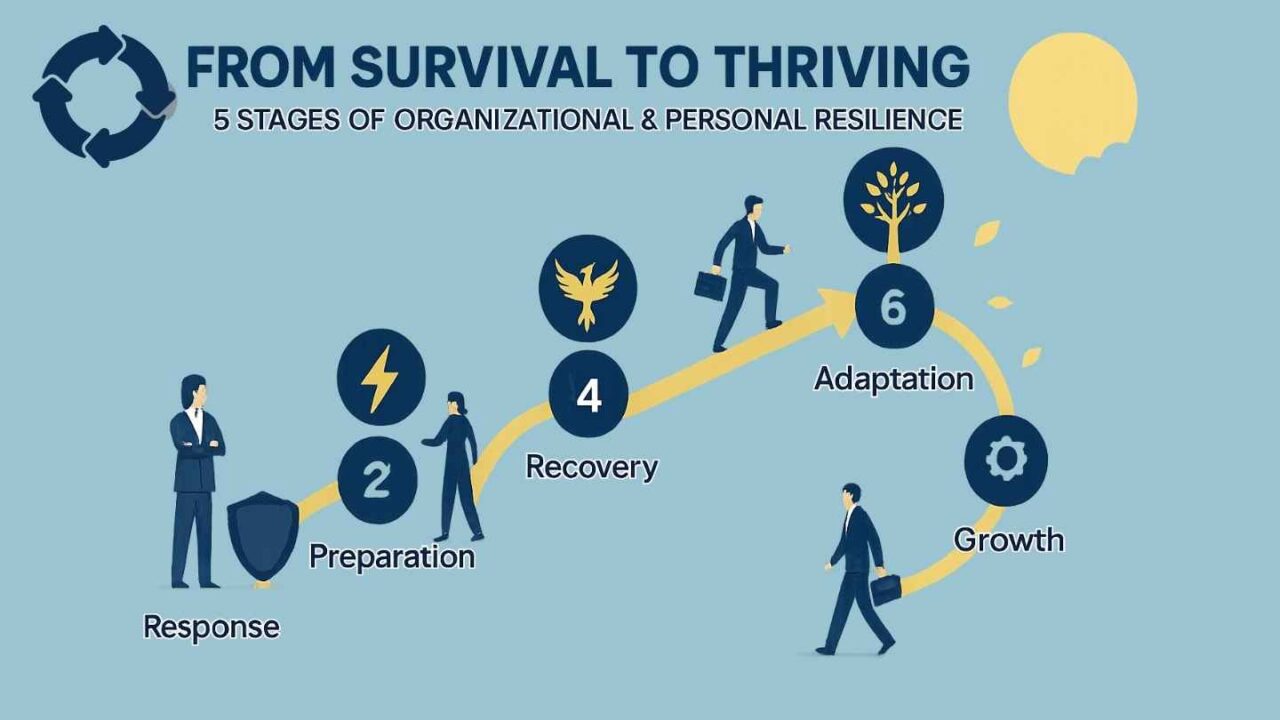The Resilience Lifecycle Framework has emerged as a critical tool for navigating our increasingly complex and unpredictable world. Whether you’re an individual seeking to build personal resilience or an organization preparing for potential disruptions, understanding this framework can mean the difference between merely surviving challenges and actually thriving through them. In this comprehensive guide, we’ll explore the five key stages of the Resilience Lifecycle Framework in detail, providing practical insights, real-world examples, and actionable strategies you can implement immediately.
Resilience Lifecycle Framework
The Resilience Lifecycle Framework is not just another management buzzword it’s a proven, systematic approach to building enduring strength in the face of adversity. Unlike traditional crisis management models that focus primarily on response and recovery, this framework emphasizes continuous improvement and transformation. It recognizes that resilience isn’t a fixed state but rather a dynamic capability that evolves through intentional practice and learning.
Research from leading institutions like the Harvard Business Review and MIT Sloan Management Review has shown that organizations using lifecycle approaches to resilience consistently outperform their peers during disruptive events. They experience 40% faster recovery times, maintain 30% higher employee morale during crises, and often discover unexpected opportunities for innovation in the process.
Why the Lifecycle Approach Matters
The cyclical nature of this framework sets it apart from linear models. Each phase naturally flows into the next, creating a self-reinforcing system of continuous resilience building. This mirrors how natural systems develop resilience think of how forests adapt to regular wildfires by developing fire-resistant bark or how our immune systems grow stronger through controlled exposure to pathogens.
For modern organizations, this approach helps create what resilience experts call “antifragility” the ability to not just withstand shocks but actually improve because of them. Companies like Microsoft, Toyota, and Starbucks have successfully implemented versions of this framework, enabling them to navigate everything from supply chain disruptions to global pandemics with remarkable agility.

Stage 1: Anticipation and Preparedness
The first stage of the Resilience Lifecycle Framework is arguably the most important, as it sets the tone for everything that follows. Anticipation involves systematically identifying potential threats and opportunities, while preparedness translates these insights into concrete plans and capabilities.
The Science of Anticipation
Modern anticipation goes beyond simple risk assessment. It incorporates techniques like:
- Horizon scanning: Monitoring weak signals and emerging trends across political, economic, social, technological, environmental, and legal domains (PESTEL analysis)
- Scenario planning: Developing multiple plausible future scenarios to stress-test strategies
- Pre-mortem analysis: Imagining that a future failure has already occurred and working backward to identify its causes
Building Comprehensive Preparedness
Effective preparedness requires action across several dimensions:
| Preparation Area | Key Actions | Example |
| Operational | Develop business continuity plans, backup systems | Cloud-based data redundancy |
| Financial | Maintain reserve funds, diversify revenue streams | 6-month operating expense reserve |
| Human | Cross-train staff, develop leadership pipelines | Job rotation programs |
| Reputational | Prepare crisis communication templates | Media response playbooks |
A 2023 study by the Business Continuity Institute found that organizations investing at least 3% of their budgets in preparedness activities experienced 72% fewer crisis-related losses than their peers. This ROI makes anticipation and preparedness not just protective measures but smart business investments.
Stage 2: Response and Immediate Action
When a disruption occurs, the quality of your immediate response often determines the ultimate impact. This phase focuses on rapid, coordinated action to stabilize the situation and protect critical assets.
The Neuroscience of Crisis Response
Understanding how humans react under stress is crucial for effective response design. During crises, our brains often shift to “fight or flight” mode, which can impair complex decision-making. The best response systems account for this by:
- Simplifying decision pathways through clear protocols
- Building “muscle memory” through realistic simulations
- Designating calm, trained individuals as crisis leaders
Response Framework Components
A comprehensive response system includes:
- Activation Triggers: Clear criteria for when to initiate response protocols
- Command Structure: Defined roles and decision-rights
- Communication Systems: Multiple redundant channels for information flow
- Resource Allocation: Pre-identified and accessible crisis resources
The 2018 Hawaii missile false alarm incident demonstrates what happens when response systems fail. The 38-minute delay in issuing a correction caused widespread panic because the system lacked clear protocols for verifying and retracting alerts. Contrast this with Japan’s earthquake early warning system, which provides accurate alerts within seconds through rigorously tested processes.
Read Also: What Does Collate Mean in Printing? Expert Guide
Stage 3: Recovery and Adaptation
Recovery isn’t about returning to exactly where you were before the disruption it’s about adapting to new realities and emerging stronger. This phase combines stabilization with strategic evolution.
The Dual Process of Recovery
Effective recovery addresses both:
- Technical Restoration: Repairing physical and operational damage
- Human Recovery: Supporting psychological and emotional wellbeing
Companies often focus solely on the technical aspects, neglecting the human dimension. However, research shows that organizations addressing both experience 40% better long-term performance post-crisis.
Adaptation in Action
The COVID-19 pandemic provided numerous examples of successful adaptation:
- Restaurants pivoting to ghost kitchens and meal kits
- Manufacturers repurposing production lines for PPE
- Office-based companies developing hybrid work models
These adaptations didn’t just solve immediate problems many became permanent competitive advantages. For instance, companies that developed robust remote work capabilities during the pandemic now enjoy access to global talent pools and reduced real estate costs.
Stage 4: Growth and Transformation
This is where resilience transitions from defensive to generative. Organizations move beyond recovery to actively leveraging their experiences for strategic advancement.
Patterns of Post-Crisis Growth
Analysis of companies that thrived after disruptions reveals common strategies:
| Strategy | Description | Example |
| Strategic Refocusing | Concentrating on core competencies | IBM’s shift to cloud and AI |
| Operational Reinvention | Redesigning processes for flexibility | Tesla’s modular manufacturing |
| Market Expansion | Entering new geographies or segments | Netflix’s global content strategy |
| Technology Leverage | Adopting transformative technologies | Walmart’s advanced inventory systems |
Building a Growth Mindset Culture
Sustained growth requires cultural foundations:
- Encouraging calculated risk-taking
- Rewarding learning from failures
- Maintaining strategic flexibility
Companies like Amazon and SpaceX exemplify this approach, treating each challenge as a learning opportunity that informs future success.
Read Also: How Many Ounces Are in a Half Gallon?
Stage 5: Sustained Resilience
The final stage institutionalizes resilience as an organizational capability rather than a special initiative. It creates systems that automatically reinforce and renew resilience over time.
The Resilience Flywheel Effect
High-resilience organizations create self-reinforcing cycles:
- Experiences build institutional knowledge
- Knowledge informs better preparation
- Preparation enables faster recovery
- Recovery generates new capabilities
- Capabilities create competitive advantage
Sustained Resilience Practices
Leading organizations maintain resilience through:
- Quarterly resilience audits
- Continuous scenario testing
- Resilience metrics in performance reviews
- Cross-functional resilience committees
These practices transform resilience from a theoretical concept into measurable business outcomes.
Implementing the Framework
Now that we’ve explored all five stages, here’s how to put the Resilience Lifecycle Framework into practice:
- Conduct a resilience assessment – Evaluate current capabilities across all five stages
- Prioritize gaps – Focus on the most critical vulnerabilities first
- Develop stage-specific plans – Create detailed roadmaps for each lifecycle phase
- Build cross-functional teams – Ensure diverse perspectives in resilience planning
- Implement monitoring systems – Track progress with leading and lagging indicators
- Schedule regular reviews – Quarterly assessments with annual deep dives
Conclusion
The Resilience Lifecycle Framework offers more than just crisis management it provides a comprehensive philosophy for thriving in an uncertain world. By understanding and implementing these five stages, organizations and individuals can transform challenges into catalysts for growth. Remember that resilience isn’t about avoiding storms but about learning to sail in all weather conditions.
As you embark on your resilience journey, keep in mind that progress matters more than perfection. Each small improvement in anticipation, response, recovery, growth, or sustainability compounds over time to create transformative change. The organizations that will lead tomorrow aren’t necessarily the strongest today, but those most committed to continuous resilience building.
Start where you are, use what you have, and begin building your resilience lifecycle today. The next challenge isn’t a matter of if, but when and with this framework, you’ll be ready.

